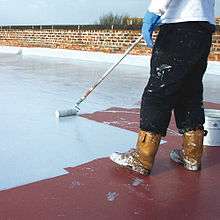Liquid roofing
Liquid Roofing is the process of waterproofing a roof by the application of a specialist liquid roof coating. It is suited to all types of roof, including flat, pitched, and domed.
History
The concept of liquid roofing has existed since (at least) the early 1800s, when natural bitumen was combined with jute, straw, rag felt and other man made materials to provide a waterproofing solution for roofs. In the early twentieth century the manufacture of liquid roof coatings became a commercial activity, with the earliest coatings being based on liquefied rubber. The 1960s and 1970s saw the introduction of acrylics, acrylic emulsions, styrene butadienes and unsaturated polyesters, which led to improved quality and durability of the coatings. In 1975, the first water based elastomeric roof coatings were introduced. In the late 1980s, single component moisture-cured polyurethane coatings were developed and remain the basis of the majority of today's cold liquid applied roof coating technologies.[1]
Concept

Liquid roofing involves the application of a monolithic, fully bonded, liquid based coating to a roof. The coating cures to form a rubber-like elastomeric waterproof membrane, capable of stretching and returning to its original shape without damage. Such coating systems are usually reinforced with secondary materials such as glass-reinforced plastic to provide additional tensile strength. The coatings can be applied over most traditional roofing materials, including felt, asphalt, bitumen, and concrete.[2] Liquid spray-applied roofing membranes have been one of the fastest growing roofing systems in North America and Europe.[3]
Benefits
Cost-effectiveness
The process of liquid roofing provides a cost-effective method of making a new or existing roof waterproof. It can deliver up to 25 years performance depending on the coating system employed. It is estimated that liquid roofing is 70% less expensive than overall roof replacement in refurbishment situations.[4]
High performance
Liquid roofing can be undertaken with high performance materials. Many of the products used in the liquid roofing process have been independently tested and their performance verified. In the United Kingdom, the leading testing and approvals house the British Board of Agrément (BBA) has been issuing approvals for liquid roofing systems since 1975.
Safety
Unlike the installation processes of felt, asphalt and bitumen membranes, liquid roofing does not involve hot works. Hot work on roofs is an extremely high-risk process, that poses a significant fire risk to contractors as well as the building and its occupants. The coating material used in the liquid roofing process is applied cold, thus negating any fire risk.
Encapsulation
When applied, liquid roofing systems encapsulate the surface they are applied to, preserving whatever is underneath and protecting it from weathering. This is especially desirable when dealing with asbestos roofs, as attempted removal of asbestos roofing can damage it, releasing material that can trigger asbestosis. Using a liquid coating system instead seals the asbestos, therefore making disturbance of the material more difficult.
Easy Application
Rapid curing even in winter. Excellent adhesion to all kinds of surfaces and chemical resistant. High resistance to extreme temperatures (between-40 °C and + 80 °C ). The membrane is completely waterproof and no heat or special equipment required.
References
- "History of Liquid Waterproofing". History of liquid waterproofing. Liquid Roofing & Waterproofing Association. Archived from the original on 1 October 2011. Retrieved 12 September 2011.
- "Liquid-Applied Monolithic Membrane Systems". Liquid-Applied Monolithic Membrane Systems. Roof Coatings Manufacturers Association. Retrieved 12 September 2011.
- https://www.wbdg.org/resources/integrity-testing-roofing-and-waterproofing-membranes
- "The benefits of liquid roofing". Why use liquid waterproofing. Liquid Roofing & Waterproofing Association. Archived from the original on 1 October 2011. Retrieved 12 September 2011.